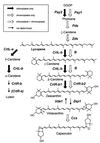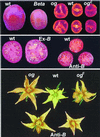An alternative pathway to beta -carotene formation in plant chromoplasts discovered by map-based cloning of beta and old-gold color mutations in tomato
- PMID: 10995464
- PMCID: PMC27155
- DOI: 10.1073/pnas.190177497
An alternative pathway to beta -carotene formation in plant chromoplasts discovered by map-based cloning of beta and old-gold color mutations in tomato
Abstract
Carotenoid pigments in plants fulfill indispensable functions in photosynthesis. Carotenoids that accumulate as secondary metabolites in chromoplasts provide distinct coloration to flowers and fruits. In this work we investigated the genetic mechanisms that regulate accumulation of carotenoids as secondary metabolites during ripening of tomato fruits. We analyzed two mutations that affect fruit pigmentation in tomato (Lycopersicon esculentum): Beta (B), a single dominant gene that increases beta-carotene in the fruit, and old-gold (og), a recessive mutation that abolishes beta-carotene and increases lycopene. Using a map-based cloning approach we cloned the genes B and og. Molecular analysis revealed that B encodes a novel type of lycopene beta-cyclase, an enzyme that converts lycopene to beta-carotene. The amino acid sequence of B is similar to capsanthin-capsorubin synthase, an enzyme that produces red xanthophylls in fruits of pepper (Capsicum annum). Our results prove that beta-carotene is synthesized de novo during tomato fruit development by the B lycopene cyclase. In wild-type tomatoes B is expressed at low levels during the breaker stage of ripening, whereas in the Beta mutant its transcription is dramatically increased. Null mutations in the gene B are responsible for the phenotype in og, indicating that og is an allele of B. These results confirm that developmentally regulated transcription is the major mechanism that governs lycopene accumulation in ripening fruits. The cloned B genes can be used in various genetic manipulations toward altering pigmentation and enhancing nutritional value of plant foods.
Figures






References
-
- Mayne S T. FASEB J. 1996;10:690–701. - PubMed
-
- Gann P H, Ma J, Giovannucci E, Willett W, Sacks F M, Hennekens C H, Stampfer M J. Cancer Res. 1999;59:1225–1230. - PubMed
-
- Giovannucci E. J Natl Cancer Inst. 1999;91:317–331. - PubMed
-
- Cunningham F X, Gantt E. Annu Rev Plant Physiol Plant Mol Biol. 1998;49:557–583. - PubMed
-
- Harker M, Hirschberg J. Methods Enzymol. 1998;297:244–263.
Publication types
MeSH terms
Substances
Associated data
- Actions
LinkOut - more resources
Full Text Sources
Other Literature Sources
Miscellaneous

